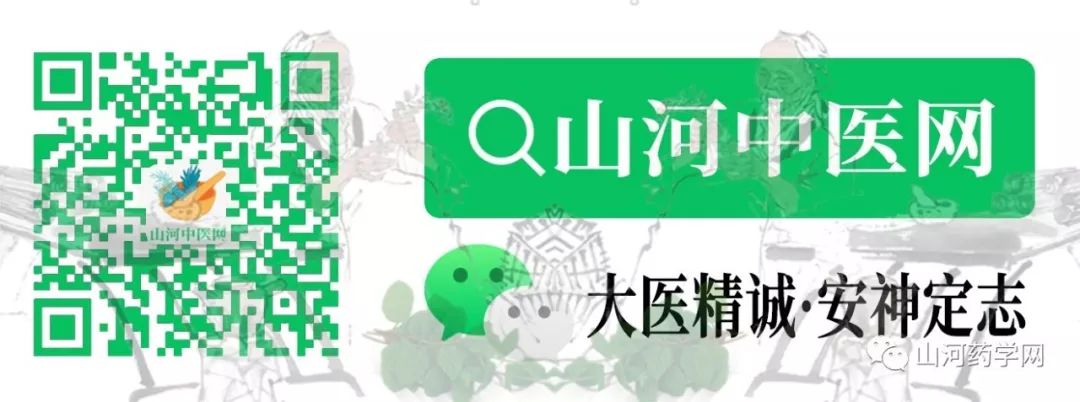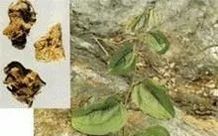| Bá Qiā (Smilax china) | |
|---|---|
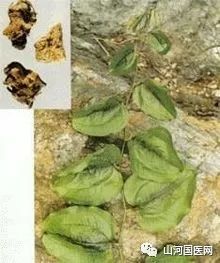 |
|
| Alias | Jīngāngténg (Iron Thorn), Tiělíngjiǎo (Iron Horn), Mǎjiālè (Maca), Jīngǔzhùzi (Bone Column), Hóngdēngguǒ (Red Lantern Fruit), Jīngānggēn (Iron Root), Wángguācǎo (King Melon Grass), Jīngānggǔ (Iron Bone), Shānlíér (Mountain Pear), Jīngāngshù (Iron Tree), Tiěshuāzi (Iron Brush), Jīngāngcì (Iron Thorn), Jīngāngtóu (Iron Head), Jiǎbǐxiè (False Rhizoma), Shānlíngjiǎo (Mountain Horn), Bàwángyǐn (Overlord’s Pull), Gōugǔcì (Gully Thorn), Jīnbādǒu (Golden Eight Dou), Chāigǒucì (Wolf Thorn), Hòukétián (Horseshoe Vine), Mǎjiǎ (Horse Armor), Yìngfàn tóu (Hard Rice Head), Lěngfàn tóu (Cold Rice Head), Lóngzhuǎocài (Dragon Claw Vegetable), Pǔtiē (Universal Paste), Jīlivergēn (Chicken Liver Root), Lùbiānshuā (Roadside Brush), Hòuké cì (Horseshoe Thorn), Tiěcìlín (Iron Thorn Lin), Fànbādǒ (Rice Eight Dou), Lěngfàn bā (Cold Rice Eight), Bàwánglì (Overlord Power), Jīngāngbiān (Iron Whip), Mǎ’āngōng (Saddle Palace), Mǎjiācìdōu (Maca Thorn) |
| Effects | Dispels wind and dampness; detoxifies and reduces swelling. Indicated for wind-damp bi pain; cloudy urination; leukorrhea; diarrhea; dysentery; carbuncles and abscesses; stubborn skin diseases; burns and scalds. |
| First Recorded In | “Ming Yi Bie Lu” |
| Toxicity | Non-toxic |
| Meridians | Liver Meridian, Kidney Meridian |
| Nature | Warm |
| Taste | Sweet |
Basic Information
Chinese Pinyin: bá qiā
Family: Liliaceae, Bá Qiā genus
Alias: Jīngāngténg (Iron Thorn), Tiělíngjiǎo (Iron Horn), Mǎjiālè (Maca), Jīngǔzhùzi (Bone Column), Hóngdēngguǒ (Red Lantern Fruit), Jīngāngcì (Iron Thorn), Jiǔniúlì (Nine Cattle Power)
Other Names: Jīngānggēn (Iron Root), Wángguācǎo (King Melon Grass) (“Rihua Zibencao”), Jīngānggǔ (Iron Bone) (“Rumen Shiqin”), Jīngāngténg (Iron Thorn) (“Lǚchán Yán Bencao”), Shānlíér (Mountain Pear), Jīngāngshù (Iron Tree), Tiěshuāzi (Iron Brush) (“Jiùhuāng Bencao”), Tiělíngjiǎo (Iron Horn) (“Gangmu”), Jīngāngcì (Iron Thorn) (“Yīlín Zuànyào”), Jīngāngtóu (Iron Head), Jiǎbǐxiè (False Rhizoma), Shānlíngjiǎo (Mountain Horn), Bàwángyǐn (Overlord’s Pull) (“Língnán Cǎiyào Lù”), Gōugǔcì (Gully Thorn), Jīnbādǒu (Golden Eight Dou), Chāigǒucì (Wolf Thorn), Hòukétián (Horseshoe Vine) (“Guǎngzhōu Zhíwù Zhì”), Mǎjiǎ (Horse Armor), Yìngfàn tóu (Hard Rice Head), Lěngfàn tóu (Cold Rice Head) (“Guǎngzhōu Zhíwù Zhì”), Lóngzhuǎocài (Dragon Claw Vegetable) (“Guìzhōu Mínjiān Fāngyào Jí”), Pǔtiē (Universal Paste) (“Fújiàn Mínjiān Cǎoyào”), Jīlivergēn (Chicken Liver Root) (“Guǎngxī Zhōng Shòuyī Yào Zhí”), Hòuké cì (Horseshoe Thorn) (“Mǐnán Mínjiān Cǎoyào”), Tiěcìlín (Iron Thorn Lin) (“Zhèjiāng Mínjiān Cǎoyào”), Fànbādǒ (Rice Eight Dou) (“Sìchuān Zhōngyào Zhì”), Jīngāngbiān (Iron Whip) (“Jiāngxī Zhōngcǎoyào Xué”).
Expert Commentary: “Gangmu”: “Bá Qiā has a warm qi and sour taste, with astringent and astringent properties, similar to Bǐxiè (Rhizoma Dioscoreae).”
Growth Habits: Prefers sunlight, slightly shade-tolerant, drought-resistant, and can grow in poor soil.
Landscape Use: The fruit of Bá Qiā is bright red and can be used to climb rocks and artificial hills, as well as for ground cover.
Plant Morphology: Leaves are alternate, broadly ovate or round, 3-10 cm long, entire margin. Flowers are unisexual and dioecious, greenish-yellow, clustered in umbellate inflorescences; flowering period is April to May. Berries are spherical and red;
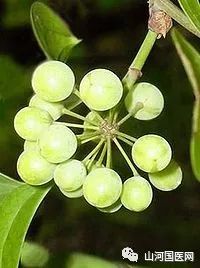
 Fruit
Fruit
Fruits ripen in September to October. Prefers sunlight, slightly shade-tolerant, drought-resistant, and can grow in poor soil.
Distributed in southwestern, central, and eastern China, as well as in Korea and Japan.
The bright red fruit of Bá Qiā can be used to climb rocks and artificial hills, as well as for ground cover.
Propagation can be done by sowing seeds or dividing rhizomes.
Climbing shrub. The rhizome runs horizontally, irregularly curved, thick and hard, with sparse fibrous roots. The stem is hard, 0.7 to over 2 meters tall, with sparse spines that are either downward or horizontal. Leaves are alternate, leathery, round to broadly ovate, 5-7 cm long, 2.5-5 cm wide, with a pointed or rounded apex, rounded or broadly wedge-shaped base, sometimes nearly heart-shaped, entire margin, 3-5 veins, green underneath; petioles are 4-5 mm long, with two tendrils on the lower sides of the petiole. Flowers are unisexual, dioecious; umbellate inflorescences, axillary; bracts are ovate-lanceolate; perianth segments are 6, in 2 whorls, oblong, yellow-green; male flowers are about 6 mm in diameter, with 6 stamens, short filaments about 4 mm long, anthers yellow; female flowers are smaller; about 3 mm in diameter, with degenerated stamens into thread-like structures, ovary superior, elongated oval, 3-celled, with a 3-lobed stigma, slightly recurved. Berries are spherical and red. Flowering period is April to May.
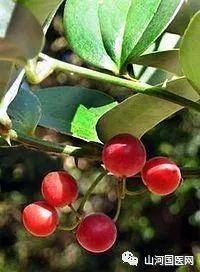
 Mature Fruit
Mature Fruit
Grows on hillsides and the edges of shrub forests. Distributed throughout southern China, south of the Yangtze River.
Bá Qiā prefers abundant sunlight, is relatively resistant to sprouting, drought-resistant, heat-resistant, and can grow in various soils, thriving in loose, fertile sandy soil. Use one-year-old rhizomes with buds for planting in winter or spring, with a spacing of 0.5 meters, applying some organic fertilizer as a base fertilizer before planting. To promote flowering and fruiting, appropriate application of phosphorus and potassium fertilizer during the flower bud differentiation and fruiting period is recommended. During the autumn dry season, water every half month, and after leaf fall in winter, promptly prune thin branches, dense branches, crossing branches, and dead branches from the base of the stem.
Medicinal Material
The dried rhizome is slightly cylindrical, slightly curved, with nodular formations and irregular depressions. It is about 8-15 cm long and 2-4 cm in diameter. The surface is brownish-purple, slightly shiny, with nodular swellings often having hard fibrous root remnants and bud scars, or leaving hard, curved fine roots. The texture is hard and difficult to break, with a yellow-brown cross-section that is flat. The specimens from Jiangsu are finer and longer, commonly known as “Jīngāngbiān” (Iron Whip); those from Zhejiang are thicker, commonly known as “Tiělíngjiǎo” (Iron Horn).
Collection: Harvest the rhizomes in February or August, remove the soil and fibrous roots, and dry in the sun.
Chemical Composition: The rhizome contains diosgenin and various saponins derived from diosgenin. It also contains alkaloids, phenolic compounds, amino acids, organic acids, and sugars. The seed oil contains 11.2% crude fat, with fatty acids including 48.4% oleic acid and 39.1% linoleic acid.
Source: The rhizome of the plant Bá Qiā (Smilax china L.) from the Liliaceae family. Its leaves (Bá Qiā yè) are also used medicinally. Harvestable year-round, wash, slice, and dry, or soak in salt water for several hours, then steam and dry. Leaves can be harvested in summer and dried.
Pharmacological Effects:
1. Diuretic and detoxifying effects: The decoction did not increase urine output in dogs during acute diuretic experiments, nor did it have diuretic effects on acutely mercury-poisoned rats, but it slightly increased the amount of mercury excreted in urine. It had no significant effect on the reticuloendothelial system function in normal rabbits and acutely mercury-poisoned rabbits.
2. Anti-trypanosomiasis effects: 25% and 50% decoctions, whether administered by gavage or intraperitoneal injection, could temporarily inhibit the reproduction of equine trypanosomiasis, delaying the death time of mice, but could not clear the trypanosomes from the blood to cure the mice. Both methods caused abdominal distension in mice. The former combined with Portulaca oleracea showed increased efficacy and reduced side effects, and had antibacterial effects against Staphylococcus aureus, Pseudomonas aeruginosa, and Escherichia coli in vitro.
Preparation: Wash the raw drug with clean water, soak, slice thinly, and dry in the sun.
Taste and Properties: Sweet, sour, neutral, warm.
1. “Bie Lu”: “Taste is sweet, neutral, non-toxic.”
2. “Jiùhuāng Bencao”: “Taste is sweet and sour.”
Meridians: “Gangmu”: “Foot Jueyin, Shaoyin.”
Main Functions and Indications: Dispels wind and dampness, detoxifies and reduces swelling. Rhizome: treats wind-damp joint pain, traumatic injuries, gastroenteritis, dysentery, indigestion, diabetes, chyluria, leukorrhea, cancer; leaves: externally used for carbuncles, boils, and burns.
Dispels wind-dampness, promotes urination, reduces swelling and toxicity. Treats joint pain, muscle numbness, diarrhea, dysentery, edema, gonorrhea, carbuncles, swelling and toxicity, scrofula, hemorrhoids.
1. “Bie Lu”: “Indicated for cold pain in the waist and back, wind bi, benefits blood and qi, stops frequent urination.”
2. “Rihua Zibencao”: “Treats seasonal diseases and pestilence.”
3. “Pǐnhuì Jīngyào”: “Disperses swelling and toxicity.”
4. “Gangmu”: “Treats thirst, blood loss, and diarrhea.”
5. “Bencao Yuanshi”: “Promotes urination.”
6. “Yīlín Zuànyào”: “Soothes the liver and strengthens the kidneys, clears small intestine fire, transforms bladder water. Treats ulcers, toxic sores, and insect poison.”
7. “Nánjīng Mínjiān Yàocǎo”: “Transforms phlegm and stops cough. Soaked in wine, can treat muscle and bone numbness.”
8. “Fújiàn Mínjiān Cǎoyào”: “Treats hernia.”
9. “Jiāngsū Zhíyào Zhì”: “Soaked in wine, treats pain in the heart.”
10. “Zhèjiāng Mínjiān Cǎoyào”: “Treats flowing fire.”
11. “Sìchuān Zhōngyào Zhì”: “Clears heat, removes wind toxicity. Treats excessive leukorrhea, blood in urine, scrofula, traumatic injuries.”
12. “Guǎngzhōu Bùduì Chángyòng Zhōngcǎoyào Shǒucè”: “Dispels wind and dampness. Treats pain in the waist and legs, rheumatoid arthritis, and intestinal inflammation with diarrhea.”
13. “Jiāngxī Zhōngcǎoyào Xué”: “Detoxifies and dispels wind, essential medicine for sores and carbuncles. Treats gout-like joint pain, muscle paralysis, esophageal cancer, and psoriasis.”
Dosage and Administration: Internal use: decoction, 3-5 qian (15-25 g), large dose 1-3 liang (30-90 g); soaked in wine or made into pills or powders. External use: decoction for fumigation and washing.
Selected Formulas:
1. For joint wind-damp pain: Tiěcìlín (Iron Thorn), Huóxuèlóng (Blood-Activating Dragon), Shānhaw (Hawthorn Root) each 3-5 qian. Decoction for oral administration. (“Zhèjiāng Mínjiān Cǎoyào”)
2. For chronic foot pain, unable to walk, lumbar spine spasm, and abdominal tightness: Clean Bá Qiā, chop, 1 hu (about 1.5 liters), boil with 3 hu (about 4.5 liters) of water until reduced to 9 dou (about 1.5 liters), soak rice and brew like wine, drink when cooked. (“Bǔquē Zhǒuhòu Fāng”)
3. For muscle and bone numbness: Soak Bá Qiā in wine and take. (“Nánjīng Mínjiān Yàocǎo”)
4. For thirst and continuous drinking: Bá Qiā (chopped and stir-fried), 1 liang (30 g) each of soda and 2 dried black plums (crushed and baked). Grind coarsely and sift. Take 2 qian (6 g) with a cup of water, boil down to 7 parts, strain, and drink warm. (“Pǔjì Fāng” Bá Qiā Drink)
5. For frequent urination and incontinence: Jīngānggǔ (Iron Bone) powdered, mixed with good wine, 3 qian (9 g), take. (“Rumen Shiqin”)
6. For dysentery (red and white): Jīngānggēn (Iron Root) and good wax tea in equal parts, powdered, make into pills the size of a chicken head. Take 5-7 pills, for children 3 pills. Take with red dysentery licorice soup, white dysentery black plum soup, or red and white dysentery black plum licorice soup. (“Lǚchán Yán Bencao”)
7. For sand and stone dysuria: 2 liang (60 g) of Bá Qiā, pound and sift into fine powder. Take 1 qian (3 g) with rice drink. After taking, use local pepper decoction for bathing, immersing the waist. (“Shèngjì Zǒnglù Bá Qiā Powder”)
8. For chyluria: 1 liang (30 g) of Zǐmù (Bird Does Not Rest) root and Bá Qiā rhizome. Boil in water, divide into two doses for morning and evening. (“Quánzhǎn Xuǎnbiān. Infectious Diseases”)
9. For esophageal cancer: 1 jin (500 g) of fresh Bá Qiā. Use 3 jin (1.5 liters) of cold water, concentrate to 1 jin (500 g), remove residue, add 2 liang (60 g) of fatty pork, and cook until the pork is done. This is a daily dose, divided into three doses. (“Zhōngcǎoyào Zhì Zhǒngliú Zīliào Xuǎnbiān”)
10. For red and white leukorrhea: 0.5 jin (250 g) of Bá Qiā, pound and decoct, add 2 liang (60 g) of sugar. Take daily. (“Jiāngsū Yàocái Zhì”)
11. For flowing fire: Tiěcìlín decoction with pig’s feet for food, or combined with 2 qian (6 g) of local cow knee for decoction. (“Zhèjiāng Mínjiān Cǎoyào”)
Clinical Applications:
1. Treatment of acute surgical infections: 1 jin (500 g) of Bá Qiā root chopped, 25 g of licorice, decocted twice, combine the filtrate and concentrate to about 1000 ml, with a concentration of Bá Qiā root equivalent to 50%. Take 50 ml each time, twice daily. Outpatient treatment of 67 cases of furuncles and carbuncles, with follow-up of 27 cases showing significant efficacy; 63 cases of cellulitis, lymphadenitis, and mastitis, with follow-up of 48 cases showing significant efficacy in 43 cases, and 5 cases with no significant effect; 8 cases of abdominal inflammatory masses and appendiceal abscesses, with follow-up of 7 cases showing significant efficacy in 6 cases, and 1 case with no significant effect.
2. Treatment of rheumatoid arthritis: Take 2 jin (1 kg) of fresh Bá Qiā root, extract with ethanol to prepare 300 ml of injection, 2 ml per ampoule. Inject 2 ml each time, once daily. Treated 52 cases, with 15 cases cured, 10 cases showing significant efficacy, 23 cases improved, and 4 cases ineffective.
3. Treatment of psoriasis: Take 20-40 g of Bá Qiā root, soak in 1500 ml of warm water for 10 hours, boil for 40-80 minutes, take after meals divided into 3 doses. Treated 107 cases, with 13 cases cured (symptoms disappeared, skin lesions disappeared, or only a few small lesions remained), 26 cases showing significant efficacy (symptoms basically disappeared, skin lesions reduced by about 60-80%), 46 cases effective (symptoms significantly reduced, skin lesions disappeared by about 30-60%, or skin lesions generally flattened, reduced redness, and decreased scales), and 23 cases ineffective. Cured cases had some recurrence after stopping medication, but generally milder, and re-administration of Bá Qiā was still effective.
4. Treatment of cancer: Clean and slice Bá Qiā root, dry, and use 0.5-1 jin (250-500 g) of dry product soaked in 6-7 jin (3-3.5 liters) of water, after 1 hour, simmer for 3 hours to remove residue, add 1-2 liang (30-60 g) of fatty meat and simmer for another hour, yielding about 500 ml of decoction, to be taken multiple times within a day. Suitable for gastric cancer, esophageal cancer, rectal cancer, breast cancer, cervical cancer, and nasopharyngeal cancer, with better effects on gastric and esophageal cancers. It enhances appetite, reduces vomiting, relieves esophageal narrowing, promotes urination and reduces swelling, enhances physical strength, increases red blood cells and hemoglobin, and has certain analgesic and sedative effects. Observations on 200 cases (varying severity) showed that about 45% of patients achieved short-term efficacy, with symptom relief; some cases achieved cure; some controlled for 1 year without symptoms; a few cases showed tumor shrinkage, but most showed no change. This product is more suitable for patients with spleen and stomach deficiency and cold constitution; such patients feel gastrointestinal comfort, reduced bloating, increased appetite, and significant reduction of mucus in esophageal cancer patients. Conversely, those with yin deficiency and heat constitution often experience dry mouth, irritability, constipation, red urine, oral mucosal ulceration, or blood in stool and gastrointestinal bleeding after taking it. Therefore, it is not suitable for patients with a series of heat reactions caused by radiotherapy. In practice, it has been observed that this drug has an inhibitory effect on pathogenic bacteria in the digestive tract and astringent effect on inflammation, congestion, and edema of the intestinal mucosa. Therefore, it has good effects on rectal and colon reactions after cervical cancer radiotherapy, with mucus and blood in stool. Since this product contains saponins and tannins, which have certain irritant effects on the gastrointestinal mucosa, it is recommended to add pork to neutralize the saponins and impurities to avoid gastrointestinal irritation causing nausea and vomiting.
Chemical Composition of Traditional Chinese Medicine:
The root contains Smilaxin, isoengeletin, oleanolic acid, kaempferide, dihydrokaempferide, β-sitosterol, β-sitosterol glucoside, prosapogenin A of diosgenin, diosgenin, gracillin, methylprotogracillin, methylprotodioscin, and others. Neotigogenin-3-O-α-L-rhamnopyranosyl-(1→6)-β-D-glucopyranoside, neotigogenin-3-O-β-D-glucopyranosyl-(1→4)-O-[α-L-rhamnopyranosyl-(1→6)]-β-D-glucopyranoside, pseudoprotodioscin, isonarthogenin-3-O-α-L-rhamnopyranosyl-(1→2)-O-[α-L-rhamnopyranosyl-(1→4)]-β-D-glucopyranoside, diosgenin.
Identification of Medicinal Materials:
Physical Identification: The rhizome is flat cylindrical, slightly curved, or irregularly shaped, 10-20 cm long, 2-4 cm in diameter. The surface is yellow-brown or purple-brown, with conical protrusions of stem scars, bud scars, and fine root breakage at nodular swellings, or leaving hard broken fine roots, spiny, with scales at the nodes; sometimes the tip retains the above-ground stem. The texture is hard, with a brownish-yellow or reddish-brown cross-section, coarse fibrous. It has a slight odor and a slightly bitter taste. The best specimens are those with thick rhizomes and a red cross-section.
Microscopic Identification: Powder characteristics: light brownish-red.
1. Starch granules are round or semi-spherical, 5-30 μm in diameter, with hilum points, fissures, or bird-like shapes; compound granules are rare, composed of 2-4 granules.
2. Stone cells are scattered singly or in groups, light yellow or reddish-brown, round, long oval, square, or irregular, 40-195 μm in diameter, with walls 8-45 μm thick, lignified, with obvious pores, and small cell cavities, some containing reddish-brown substances.
3. Short fibers are easily seen, light yellow, rectangular or short fusiform, with slightly lignified walls.
4. Calcium oxalate needle crystals are 75-140 μm long, occasionally found in bundles within mucilage cells.
Disclaimer:The content of this site is added and organized by users for learning and reference purposes only. The information on the site may not be accurate, comprehensive, or up-to-date, and the content should not be the final basis for diagnosing or treating diseases.Shanhe TCM Networkreminds users that if there are any physical discomforts, please seek medical attention promptly. Thank you for your support and love; we will strive to do better~!!!
